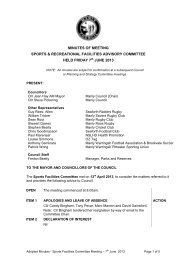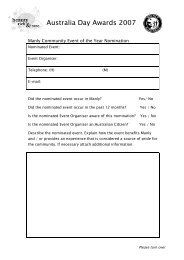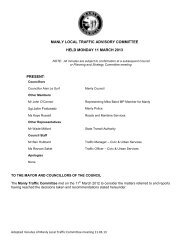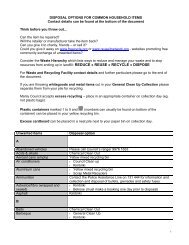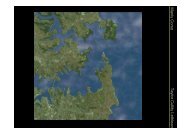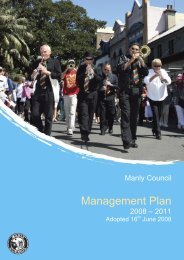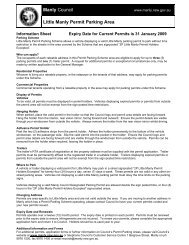Manly Lagoon Dredging Project - Manly Council - NSW Government
Manly Lagoon Dredging Project - Manly Council - NSW Government
Manly Lagoon Dredging Project - Manly Council - NSW Government
- No tags were found...
You also want an ePaper? Increase the reach of your titles
YUMPU automatically turns print PDFs into web optimized ePapers that Google loves.
<strong>Manly</strong> <strong>Lagoon</strong> <strong>Dredging</strong> <strong>Project</strong> – Review of Environmental FactorsPrepared for <strong>Manly</strong> and Warringah <strong>Council</strong>san Acid Sulfate Soils Management Plan (ASSMP). An ASSMP has been prepared toensure that these risks are appropriately managed and is contained in Appendix E. Any disturbed vegetation along the bank will be restored at the completion ofdredging activities to its existing condition to the satisfaction of <strong>Manly</strong> and Warringah<strong>Council</strong>s. The dredger, and any other powered equipment will be diesel driven, and is expectedto require refuelling approximately once per week. Diesel will be supplied in a selfbunded road tank, and during refuelling inflatable booms will be placed around thedredger to contain any accidental spillage. Access for plant associated with dredging activities will be via a temporary haulageaccess from either Kentwell Road or Pittwater Road through Nolan Reserve to thelagoon bank. Any damage to kerbs or grassed areas will be reinstated followingcompletion of the project.2.5.2 Proposal TimingThe proposed dredging works are expected to commence in the third quarter of 2010. Theduration of dredging works will be approximately 30 days. The geobags will need be storedon site, along the foreshore of <strong>Manly</strong> <strong>Lagoon</strong> (Appendix M), for approximately four weeks tocomplete the dewatering process. Hence overall dredging works, sediment dewatering andremoval of dewatered dredge spoil off-site are expected to take approximately eight weeks.2.5.3 Geotextile Products for DewateringHigh strength permeable geotextile products (referred to as geobags in this report) will beused to dewater the dredged sediments. Figure 2.2 shows example photographs ofgeotextile tubes (or geobags) used for dewatering. Geobags can be provided in almost anyshape and size. The general process of dewatering with geobags, will be as follows:1. Filling: The dredged sediment (in slurry form) will be pumped into the geobagcontainers after being dosed in line with a polymer and lime at a prescribed rate. Thepolymer will facilitate the dewatering process by aiding in binding the solids togetherand separating the water. The lime will mitigate any risk posed by Potential AcidSulfate Soils (PASS).2. Dewatering: Generally, over 99% of solids are captured, and relatively clearoverburden or runoff water will drain from the geobag. Overburden water will becaptured in the bunded area so testing can determine an appropriate means ofdisposal.3. Consolidation: The solids remain in the bag while the water is draining from the bag.Because sediment pore water is being expelled, a reduction in volume of the solidsgenerally occurs. This volume reduction is dependent on the nature of the sedimentand how long the material is left to dewater and consolidate in the geobags. At theend of the process the dewatered dredge spoil material can be removed and landappliedif the material is of a suitable physical and chemical composition for reuse. Ifunsuitable, the dredge spoil will be disposed of to landfill. The geobag container canbe disposed of at a landfill site or reused, for example as matting for landscapingworks.2 July 2010 Cardno (<strong>NSW</strong>/ACT) Pty Ltd 13H:\Doc\2010\Reports.2010\Rep2580v4.doc



